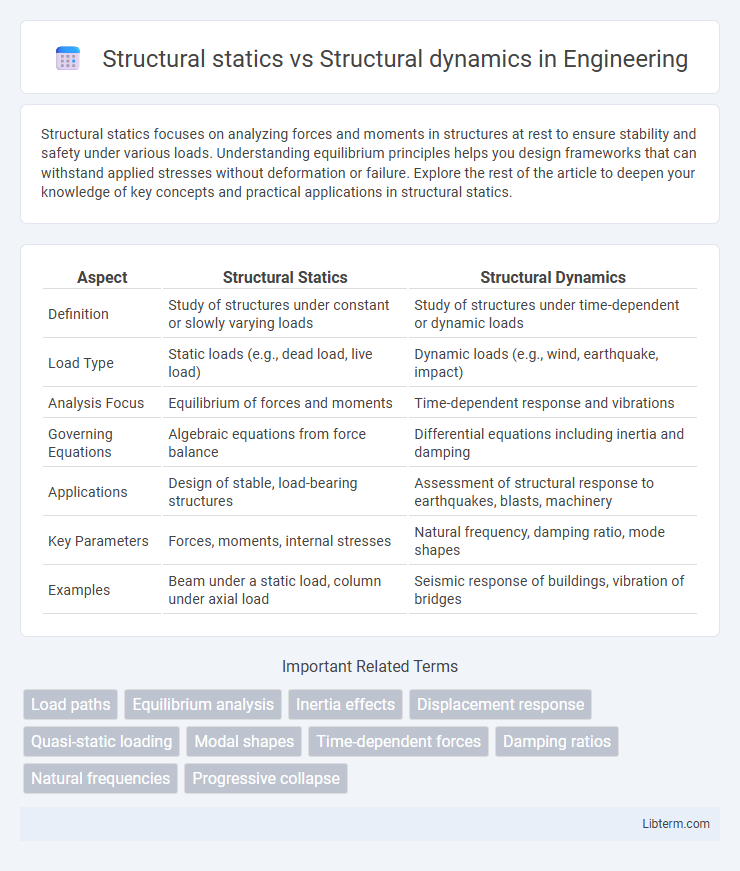Structural statics focuses on analyzing forces and moments in structures at rest to ensure stability and safety under various loads. Understanding equilibrium principles helps you design frameworks that can withstand applied stresses without deformation or failure. Explore the rest of the article to deepen your knowledge of key concepts and practical applications in structural statics.
Table of Comparison
| Aspect | Structural Statics | Structural Dynamics |
|---|---|---|
| Definition | Study of structures under constant or slowly varying loads | Study of structures under time-dependent or dynamic loads |
| Load Type | Static loads (e.g., dead load, live load) | Dynamic loads (e.g., wind, earthquake, impact) |
| Analysis Focus | Equilibrium of forces and moments | Time-dependent response and vibrations |
| Governing Equations | Algebraic equations from force balance | Differential equations including inertia and damping |
| Applications | Design of stable, load-bearing structures | Assessment of structural response to earthquakes, blasts, machinery |
| Key Parameters | Forces, moments, internal stresses | Natural frequency, damping ratio, mode shapes |
| Examples | Beam under a static load, column under axial load | Seismic response of buildings, vibration of bridges |
Introduction to Structural Statics and Structural Dynamics
Structural statics examines forces and moments acting on structures at equilibrium, ensuring stability under stationary loads without acceleration. Structural dynamics analyzes the behavior of structures subjected to time-varying loads, including vibrations, impacts, and seismic activities. Understanding both fields is essential for designing safe and efficient structures capable of withstanding static and dynamic forces.
Fundamental Concepts in Structural Statics
Structural statics involves analyzing structures under static loads to ensure equilibrium and stability, focusing on forces, moments, and reactions that do not change over time. Key concepts include equilibrium equations, free-body diagrams, and support conditions, which are essential for determining internal forces and designing safe structures. Unlike structural dynamics, which addresses time-dependent loads and inertia effects, statics provides the foundational understanding necessary for initial load assessment and structural safety.
Core Principles of Structural Dynamics
Structural dynamics focuses on analyzing how structures respond to time-varying loads, such as earthquakes, wind, and vibrations, emphasizing inertia, damping, and stiffness as core principles. Unlike structural statics, which assumes loads are constant and studies equilibrium under static forces, structural dynamics accounts for mass distribution and time-dependent forces that induce dynamic responses. Key concepts include natural frequencies, mode shapes, and dynamic amplification, which are critical for designing structures to withstand dynamic loading conditions safely.
Key Differences Between Statics and Dynamics
Structural statics analyzes forces and moments in structures at rest or in equilibrium, focusing on load distribution and support reactions without considering time-dependent effects. Structural dynamics examines the behavior of structures subjected to time-varying or dynamic loads such as earthquakes, wind, and vibrations, emphasizing inertia, damping, and natural frequencies. The key difference lies in statics assuming static loads and steady conditions, while dynamics addresses transient loads and structural responses over time.
Types of Loads in Statics and Dynamics
Structural statics primarily deals with static loads such as dead loads, live loads, and environmental loads including wind and snow, which remain constant or change slowly over time. Structural dynamics focuses on dynamic loads that vary rapidly, such as seismic forces, impact loads, and vibrations caused by machinery or traffic. Understanding the difference between static and dynamic load types is crucial for designing structures that can withstand both steady and fluctuating forces safely.
Analytical Methods Used in Structural Analysis
Structural statics relies primarily on equilibrium equations and force distribution methods such as the method of joints or sections to analyze structures under static loads. Structural dynamics employs time-dependent analytical techniques including modal analysis, time-history analysis, and response spectrum methods to evaluate structures subjected to dynamic loads like earthquakes or wind. Finite element analysis (FEA) software often integrates both static and dynamic approaches to provide comprehensive structural behavior insights.
Common Applications of Structural Statics
Structural statics primarily deals with analyzing structures under static loads such as buildings, bridges, and towers to ensure stability and safety during daily use. It is essential for designing support systems, assessing load distribution, and preventing structural failure under gravity and immovable forces. Common applications include residential construction, industrial frameworks, and civil infrastructure where static load-bearing performance is critical.
Practical Uses of Structural Dynamics
Structural dynamics is crucial for analyzing and designing buildings, bridges, and other infrastructures subjected to time-dependent forces such as earthquakes, wind loads, and impacts. This field enables engineers to predict the response of structures to dynamic events, ensuring safety and performance under real-world conditions. Practical applications include seismic design, vibration control, and response assessment of tall buildings and long-span bridges.
Challenges in Static and Dynamic Structural Design
Static structural design faces challenges such as accurately predicting load distribution and ensuring stability under constant or slowly varying loads, requiring precise material property assessments and boundary condition definitions. Dynamic structural design encounters complexities in modeling time-dependent forces like seismic activity, wind, and vibrations, demanding sophisticated computational methods to analyze transient responses and fatigue life. Both approaches must address uncertainties in load magnitudes and material behavior to optimize safety and performance in engineering applications.
Future Trends in Structural Analysis
Future trends in structural analysis emphasize the integration of real-time sensor data and machine learning algorithms to enhance predictive accuracy in both structural statics and dynamics. Advanced computational methods such as digital twins and AI-driven simulations will enable more adaptive and resilient designs, particularly in the face of climate change and seismic activity. Emphasis on sustainability and smart infrastructure necessitates the fusion of structural statics for load-bearing capacity with dynamic analysis for vibration and impact assessment, driving innovation in materials and monitoring systems.
Structural statics Infographic

 libterm.com
libterm.com